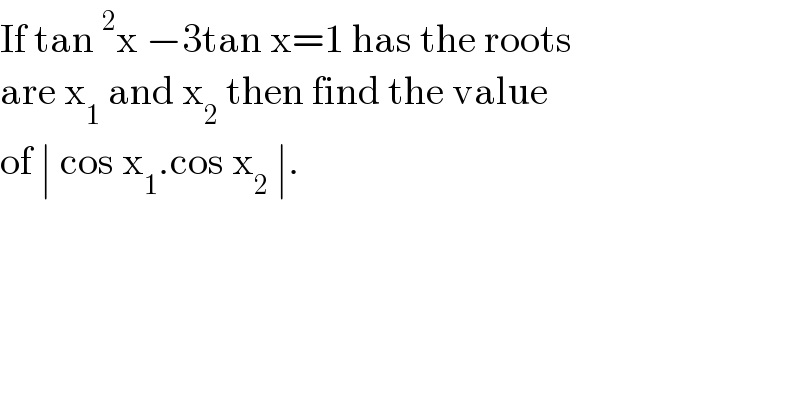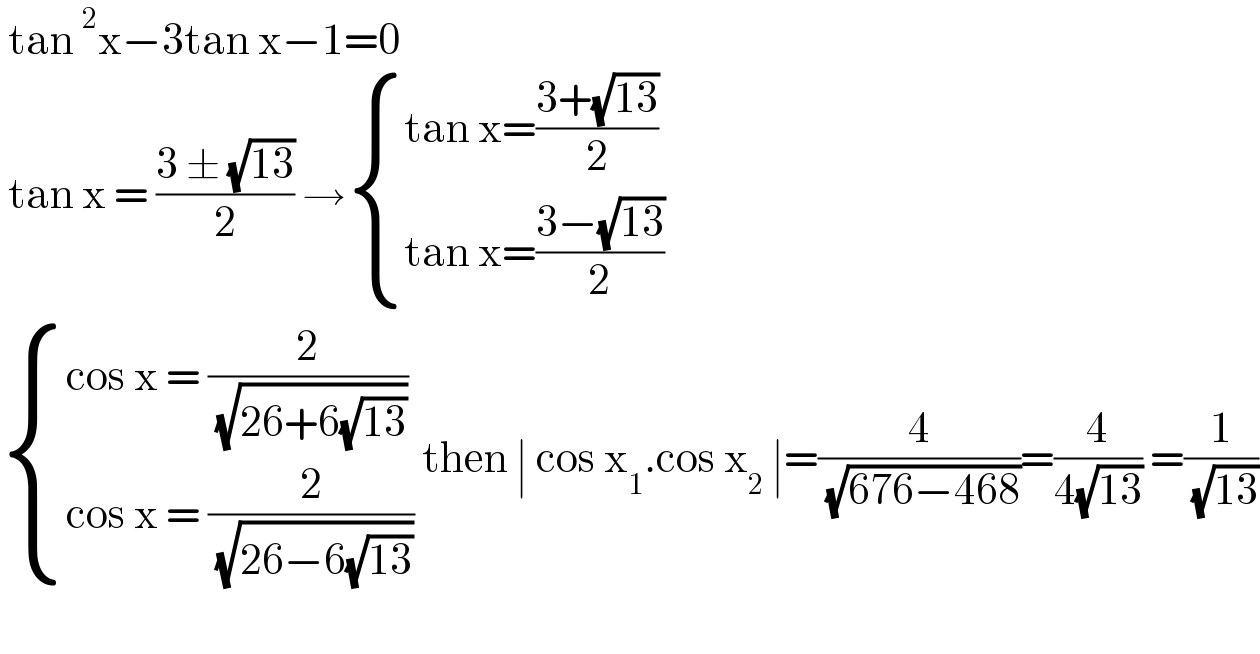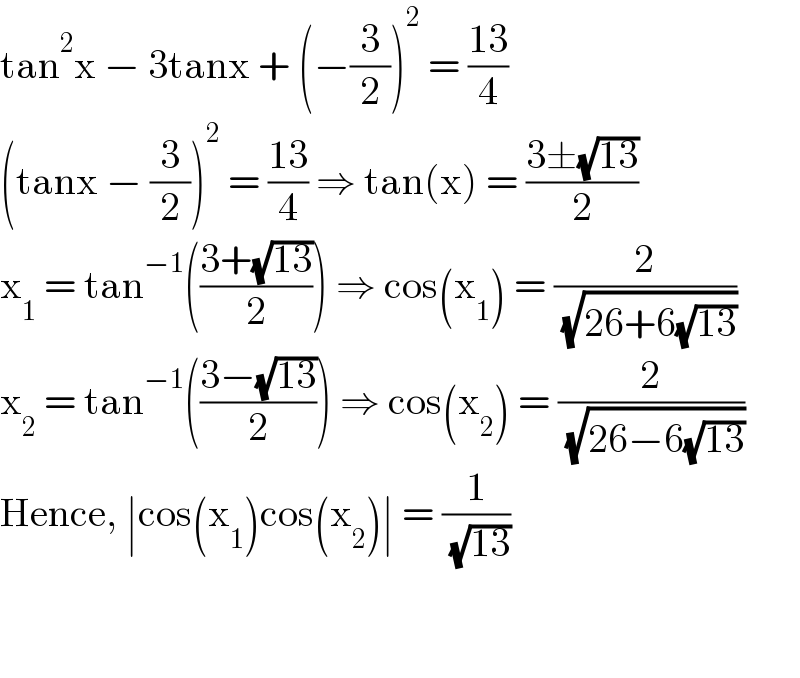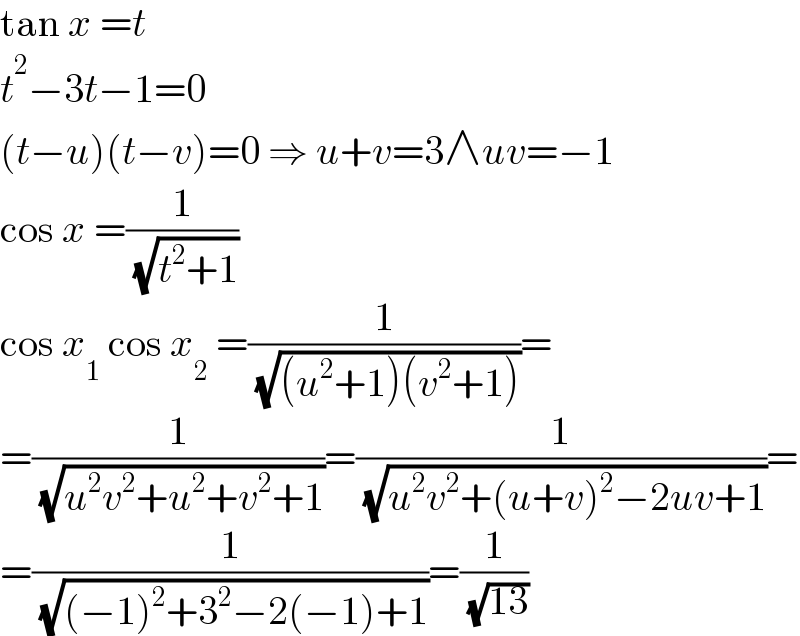
Question Number 128995 by bramlexs22 last updated on 12/Jan/21

$$\mathrm{If}\:\mathrm{tan}\:^{\mathrm{2}} \mathrm{x}\:−\mathrm{3tan}\:\mathrm{x}=\mathrm{1}\:\mathrm{has}\:\mathrm{the}\:\mathrm{roots} \\ $$$$\mathrm{are}\:\mathrm{x}_{\mathrm{1}} \:\mathrm{and}\:\mathrm{x}_{\mathrm{2}} \:\mathrm{then}\:\mathrm{find}\:\mathrm{the}\:\mathrm{value} \\ $$$$\mathrm{of}\:\mid\:\mathrm{cos}\:\mathrm{x}_{\mathrm{1}} .\mathrm{cos}\:\mathrm{x}_{\mathrm{2}} \:\mid.\: \\ $$
Commented by liberty last updated on 12/Jan/21

$$\:\mathrm{tan}\:^{\mathrm{2}} \mathrm{x}−\mathrm{3tan}\:\mathrm{x}−\mathrm{1}=\mathrm{0} \\ $$$$\:\mathrm{tan}\:\mathrm{x}\:=\:\frac{\mathrm{3}\:\pm\:\sqrt{\mathrm{13}}}{\mathrm{2}}\:\rightarrow\begin{cases}{\mathrm{tan}\:\mathrm{x}=\frac{\mathrm{3}+\sqrt{\mathrm{13}}}{\mathrm{2}}}\\{\mathrm{tan}\:\mathrm{x}=\frac{\mathrm{3}−\sqrt{\mathrm{13}}}{\mathrm{2}}}\end{cases} \\ $$$$\begin{cases}{\mathrm{cos}\:\mathrm{x}\:=\:\frac{\mathrm{2}}{\:\sqrt{\mathrm{26}+\mathrm{6}\sqrt{\mathrm{13}}}}}\\{\mathrm{cos}\:\mathrm{x}\:=\:\frac{\mathrm{2}}{\:\sqrt{\mathrm{26}−\mathrm{6}\sqrt{\mathrm{13}}}}}\end{cases}\:\mathrm{then}\:\mid\:\mathrm{cos}\:\mathrm{x}_{\mathrm{1}} .\mathrm{cos}\:\mathrm{x}_{\mathrm{2}} \:\mid=\frac{\mathrm{4}}{\:\sqrt{\mathrm{676}−\mathrm{468}}}=\frac{\mathrm{4}}{\mathrm{4}\sqrt{\mathrm{13}}}\:=\frac{\mathrm{1}}{\:\sqrt{\mathrm{13}}} \\ $$$$\: \\ $$
Answered by Lordose last updated on 12/Jan/21

$$\mathrm{tan}^{\mathrm{2}} \mathrm{x}\:−\:\mathrm{3tanx}\:+\:\left(−\frac{\mathrm{3}}{\mathrm{2}}\right)^{\mathrm{2}} \:=\:\frac{\mathrm{13}}{\mathrm{4}} \\ $$$$\left(\mathrm{tanx}\:−\:\frac{\mathrm{3}}{\mathrm{2}}\right)^{\mathrm{2}} \:=\:\frac{\mathrm{13}}{\mathrm{4}}\:\Rightarrow\:\mathrm{tan}\left(\mathrm{x}\right)\:=\:\frac{\mathrm{3}\pm\sqrt{\mathrm{13}}}{\mathrm{2}} \\ $$$$\mathrm{x}_{\mathrm{1}} \:=\:\mathrm{tan}^{−\mathrm{1}} \left(\frac{\mathrm{3}+\sqrt{\mathrm{13}}}{\mathrm{2}}\right)\:\Rightarrow\:\mathrm{cos}\left(\mathrm{x}_{\mathrm{1}} \right)\:=\:\frac{\mathrm{2}}{\:\sqrt{\mathrm{26}+\mathrm{6}\sqrt{\mathrm{13}}}}\:\:\: \\ $$$$\mathrm{x}_{\mathrm{2}} \:=\:\mathrm{tan}^{−\mathrm{1}} \left(\frac{\mathrm{3}−\sqrt{\mathrm{13}}}{\mathrm{2}}\right)\:\Rightarrow\:\mathrm{cos}\left(\mathrm{x}_{\mathrm{2}} \right)\:=\:\frac{\mathrm{2}}{\:\sqrt{\mathrm{26}−\mathrm{6}\sqrt{\mathrm{13}}}}\:\:\:\:\: \\ $$$$\mathrm{Hence},\:\mid\mathrm{cos}\left(\mathrm{x}_{\mathrm{1}} \right)\mathrm{cos}\left(\mathrm{x}_{\mathrm{2}} \right)\mid\:=\:\frac{\mathrm{1}}{\:\sqrt{\mathrm{13}}} \\ $$$$ \\ $$$$ \\ $$
Commented by liberty last updated on 12/Jan/21

$$\mathrm{i}\:\mathrm{think}\:\mathrm{it}\:\frac{\mathrm{1}}{\:\sqrt{\mathrm{13}}}\: \\ $$
Commented by Lordose last updated on 12/Jan/21

$$\mathrm{you}\:\mathrm{are}\:\mathrm{right} \\ $$$$\mathrm{I}\:\mathrm{have}\:\mathrm{found}\:\mathrm{an}\:\mathrm{error}\:\mathrm{in}\:\mathrm{my}\:\mathrm{solution} \\ $$$$\mathrm{Thanks} \\ $$
Answered by MJS_new last updated on 12/Jan/21

$$\mathrm{tan}\:{x}\:={t} \\ $$$${t}^{\mathrm{2}} −\mathrm{3}{t}−\mathrm{1}=\mathrm{0} \\ $$$$\left({t}−{u}\right)\left({t}−{v}\right)=\mathrm{0}\:\Rightarrow\:{u}+{v}=\mathrm{3}\wedge{uv}=−\mathrm{1} \\ $$$$\mathrm{cos}\:{x}\:=\frac{\mathrm{1}}{\:\sqrt{{t}^{\mathrm{2}} +\mathrm{1}}} \\ $$$$\mathrm{cos}\:{x}_{\mathrm{1}} \:\mathrm{cos}\:{x}_{\mathrm{2}} \:=\frac{\mathrm{1}}{\:\sqrt{\left({u}^{\mathrm{2}} +\mathrm{1}\right)\left({v}^{\mathrm{2}} +\mathrm{1}\right)}}= \\ $$$$=\frac{\mathrm{1}}{\:\sqrt{{u}^{\mathrm{2}} {v}^{\mathrm{2}} +{u}^{\mathrm{2}} +{v}^{\mathrm{2}} +\mathrm{1}}}=\frac{\mathrm{1}}{\:\sqrt{{u}^{\mathrm{2}} {v}^{\mathrm{2}} +\left({u}+{v}\right)^{\mathrm{2}} −\mathrm{2}{uv}+\mathrm{1}}}= \\ $$$$=\frac{\mathrm{1}}{\:\sqrt{\left(−\mathrm{1}\right)^{\mathrm{2}} +\mathrm{3}^{\mathrm{2}} −\mathrm{2}\left(−\mathrm{1}\right)+\mathrm{1}}}=\frac{\mathrm{1}}{\:\sqrt{\mathrm{13}}} \\ $$
